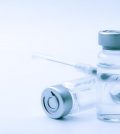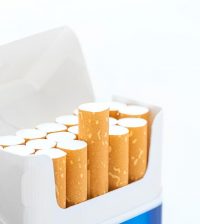- Trump Administration Withdraws Key ADA Documents
- Key HIV Care Teams Let Go, Putting Mothers and Children at Risk
- ‘Zero Suicide’ Model Leads To Fewer Suicides in Health Systems
- Stroke, Dementia, Depression Share Many Risk Factors
- Diet Drinks, Processed Foods Might Increase Type 2 Diabetes Risk
- Experimental Drug Can Slow MS Disability
- America’s ERs In Peril, Report Says
- Tasers Can Interfere With Heart Implants, Study Says
- Chronic Low Back Pain? Mindfulness Can Help
- Mehmet Oz Confirmed as Head of Centers for Medicare & Medicaid Services
Your Take-Out Coffee Cup May Shed Trillions of Plastic ‘Nanoparticles’

Maybe you ask the barista for cream with your coffee, and possibly sugar as well.
But new research shows that paper cup of joe you grab off the coffeehouse counter contains another ingredient, and it’s one you might not care for — trillions of tiny plastic particles that leach into your hot java from the cup’s plastic lining.
Single-use paper coffee cups are lined with a thin plastic film that helps keep liquids hot and prevent them from leaking through the cardboard. That lining releases more than 5 trillion plastic nanoparticles per liter when hot liquid is poured into a 12-ounce single-use cup, according to lab results published recently in the journal Environmental Science & Technology. A liter is about 34 fluid ounces.
“For reference of size of these particles, 1,000 particles with a diameter of 100 nanometers can fit across a human hair,” said lead researcher Christopher Zangmeister, a chemist and acting group leader with the Material Measurement Laboratory of the National Institute of Standards and Technology in Gaithersburg, Md. “These are very small particles.”
The researchers estimated that by the time you’ve downed 13 paper cups of hot coffee or tea, you’ve consumed the equivalent of one nanoplastic particle for every seven cells in your own body.
The liquid doesn’t need to be boiling hot to spur this release of plastic nanoparticles, either, the investigators found.
“The number of particles released into water increase rapidly with water temperature from room temperature up until about 100 degrees Fahrenheit, and then it levels off and stays constant,” Zangmeister said.
Hot beverages typically are served at temperatures between 130 and 160 degrees Fahrenheit, according to a 2019 review in the Journal of Food Science.
The researchers were quick to note that the total amount of particles that leached into hot liquid from single-use cups fell well under safe human consumption levels set by the U.S. Food and Drug Administration.
Environmental experts agree — to a point.
“I read that sentence and go, well, is it time for us to re-evaluate the guidelines?” said Christopher Reddy, a senior scientist of marine chemistry and geochemistry with the Woods Hole Oceanographic Institution in Woods Hole, Mass.
According to David Andrews, a senior scientist with the Environmental Working Group, “There is a visible global environmental crisis caused by plastic pollution, but this new research study indicates that invisible plastic nanoparticles released into our food and beverages from common plastics may be insidiously harming health.”
Andrews added that “the Food and Drug Administration should move expeditiously to require more testing and disclosure of the chemicals and nanoparticles being released from plastic food contact materials, and take necessary action to ensure that these materials are not harming health.”
These nanoparticles are small enough to slip into your bloodstream and can wind up lodged in tissues and organs located throughout your body, noted Rolf Halden, director of the Center for Environmental Health Engineering at Arizona State University.
“We really don’t know what the impact of these particles is,” Halden said. “Human exposure is increasing, and we lack the tools to even measure what is arriving in our bodies, where it is deposited and what it does there.”
Halden noted asbestos causes harm because its tiny particles are inhaled and accumulate in lung tissue, causing inflammation that can lead to scarring and cancer.
“Asbestos itself is relatively benign. It’s an inorganic material,” Halden said. “What makes it toxic and makes it kill 90,000 people a year is that it has particles that lodges in human tissue.”
For this study, Zangmeister and his colleagues poured ultra-high purity water into nylon slow-cooker bags and polyethylene-lined paper coffee cups, all obtained from different retailers.
Plastic cooking bags are used to keep food moist in the oven and make clean-up easier for slow cookers.
A bag in a slow cooker kept hot for an hour leached about 35 trillion plastic nanoparticle per liter of water, the researchers found.
Similarly, hot water poured into 12-fluid-ounce cups for 20 minutes and allowed to cool wound up leaching 5.1 trillion plastic nanoparticles per liter.
Reddy and Halden both praised the study, calling it landmark research due to the meticulous way the scientists eliminated all other potential sources of plastic pollution.
People concerned about these levels might consider bringing a metal or ceramic travel mug with them to the coffee shop, Zangmeister said.
“On a personal level, I have tried to reduce the exposure of foods and water to plastics in my life,” Zangmeister said. “Much of the plumbing in modern society is plastic, water filters are made from polymeric [plastic] materials, so elimination of plastic exposure can be a real challenge.”
Paper cup manufacturers also could make a simple change to their industrial process that could ward off human exposure to these particles, Reddy added.
“Could the industry perform a hot-water treatment on these cups before they send them out to the consumer, and pre-wash these particles away?” Reddy said. “I look at this and I go, is there an easy fix to this problem? If we exposed all our cups to one last rinse, we’d get rid of a lot of these particles.”
More information
The Plastic Health Coalition has more information about microplastics and human health.
SOURCES: Christopher Zangmeister, PhD, chemist and acting group leader, Material Measurement Laboratory of the National Institute of Standards and Technology, Gaithersburg, Md.; Christopher Reddy, PhD, senior scientist, marine chemistry and geochemistry, Woods Hole Oceanographic Institution, Woods Hole, Mass.; Rolf Halden, PhD, director, Center for Environmental Health Engineering, Arizona State University, Tempe; David Andrews, PhD, senior scientist, Environmental Working Group, Hartford, Conn.; Environmental Science & Technology, April 20, 2022
Source: HealthDay
Copyright © 2025 HealthDay. All rights reserved.










